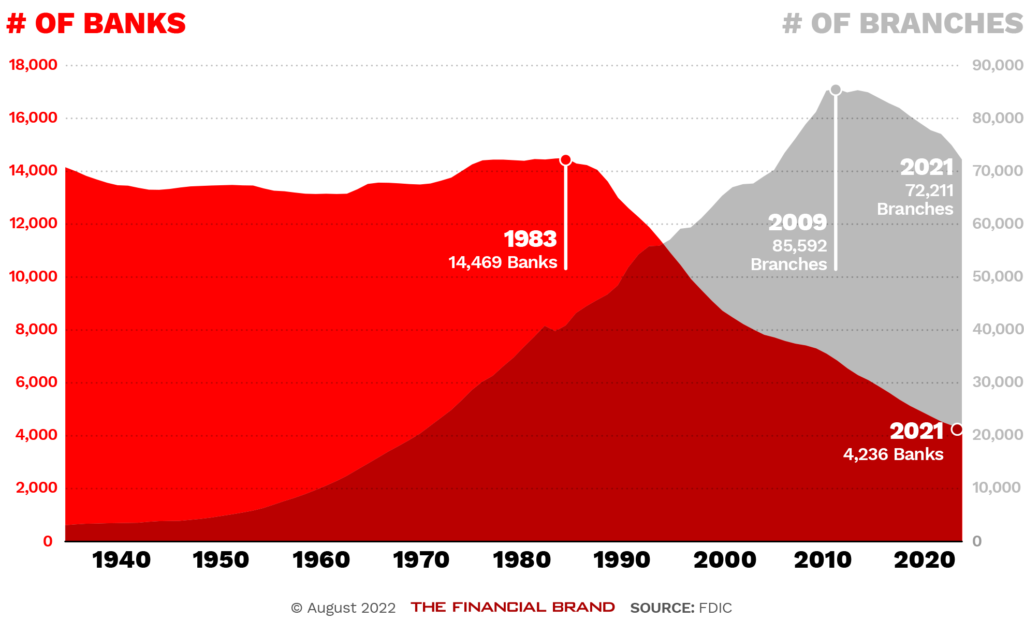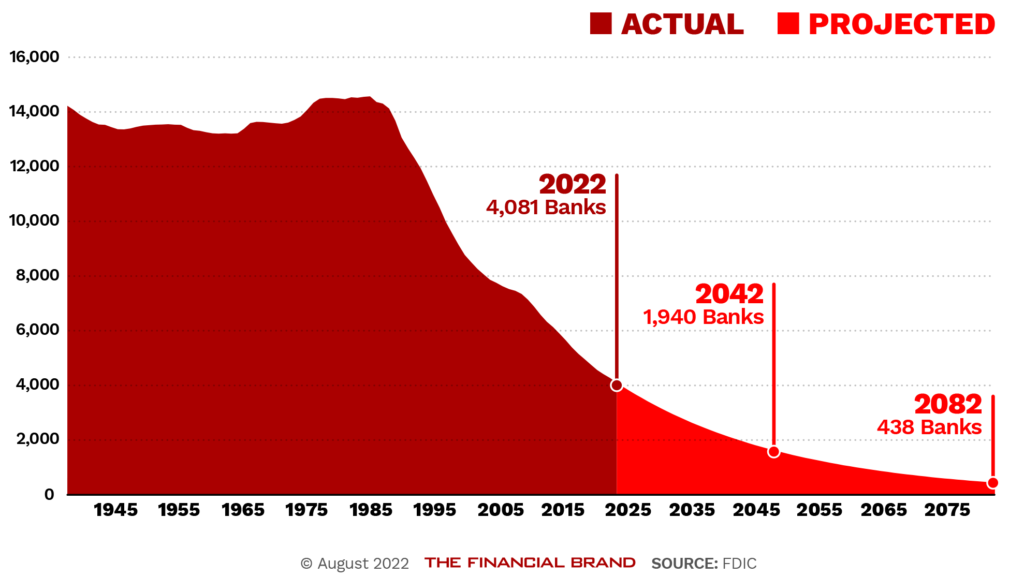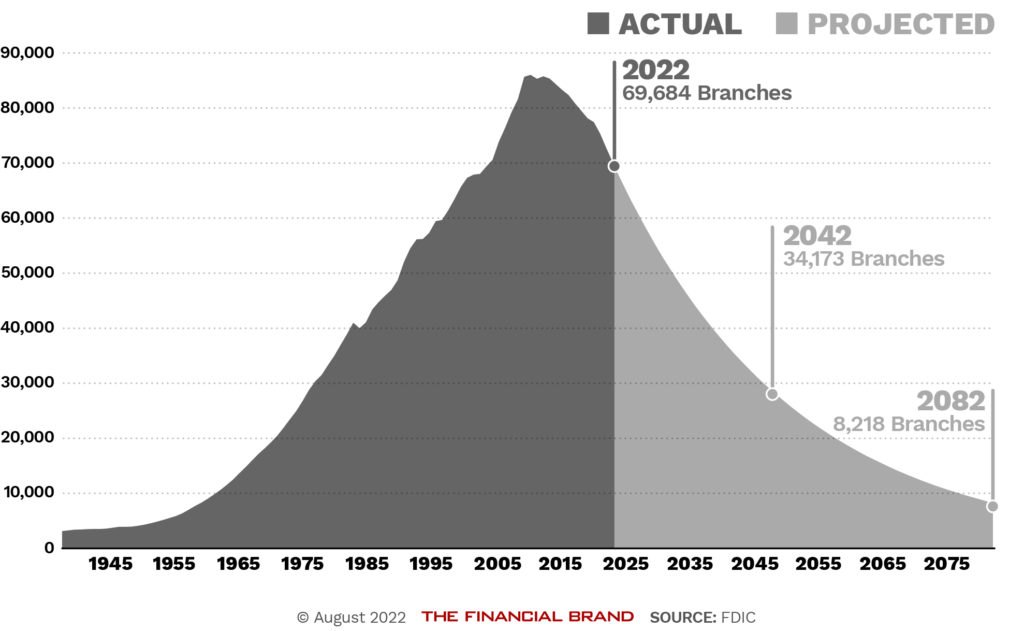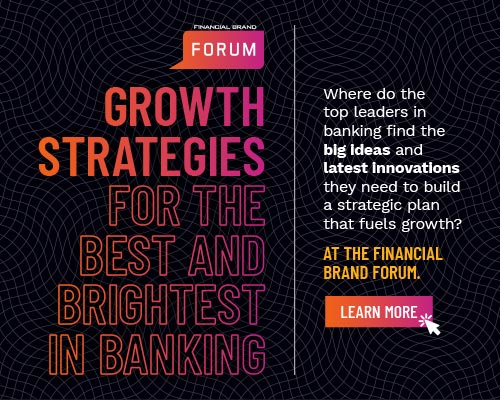The Ultimatum Facing U.S. Banks
Half of all banks in the U.S. will disappear in the next 20 years.
The Financial Brand analyzed the number of FDIC-insured banks and bank branches in the U.S. since 1935. The trends paint an alarming picture for the future of banking. In the next 20 years, half the banks around today will be gone, leaving fewer than 2,000 banks in the US by the year 2042.
By Jeffry Pilcher, CEO of The Financial Brand, with additional reporting by special contributor John Ginovsky
Over the last 40 years, some major historical events have rocked the US banking landscape, including the savings and loan crisis, and more recently, the mortgage meltdown that sparked the Great Recession. Along the way, there were also major technological developments like ATM cards and mobile banking that helped transform the industry in positive ways.
Nothing, however, had a more profound impact on the banking sector than the Great Depression. When the stock market crashed in 1929, there were over 25,000 banks in the US. By the end of the Great Depression, around 10,000 of them had failed.
This utter collapse of the banking system triggered monumental changes to the regulatory framework in the US, including the creation of the FDIC. Every year since 1935, the FDIC has released volumes of data about the banks they insure.
According to the FDIC’s data, the number of banks in the US held basically steady for 50 years. Between 1935 and 1987, the number of FDIC-insured institutions never fell below 13,000 and never rose above the 1983 peak of 14,469.
But then things started to change… with a downward trajectory. In the 10-year stretch from 1988 through 1998, the S&L crisis claimed roughly 5,000 banks among its victims. During this period, the number of banks contracted an average of 4% annually. Within a decade, one third of the banks in the US disappeared, dropping from 12,971 FDIC-insured institutions to 8,709.
Look at the chart below and you’ll see startling-but-obvious trendlines. The number of banks have been declining at an average annual rate of over 3% since the late 1980s. The number of bank branches have mirrored this decline since 2013.
After the Dot Com Bubble popped in 2000 and in the wake of the 9/11 terror attacks, the Federal Reserve slashed interest rates to their lowest levels in nearly 40 years. With cheap money sloshing around, mortgage lending boomed. From 2004 through 2008, banks built a record-breaking 15,000 new branches to maintain the flow of deposits needed to fuel the home-buying frenzy.
Coincidentally, the decline in the number of FDIC-insured institutions almost ground to a halt during this period. In 2006, at the apex of the mortgage debacle, there were just 65 fewer banks than the year prior, shrinking by a mere 0.87%, — the smallest contraction in 20 years. After all, with everyone building branches at a breakneck pace, who could afford to shutter an institution? In the midst of this home lending bonanza, any bank with branches was an highly attractive prize.
Growth Strategies and Groundbreaking Innovations in Banking
Learn how to tackle the biggest challenges in banking at The Financial Brand Forum — three days loaded with big ideas, actionable insights, and advanced strategies.
Industry Outlook: How Many Banks Will Survive?
In 2012 there were 6,087 FDIC-insured institutions with $14.4 trillion in assets. By 2021, this number had dwindled down to just 4,236 banks but assets had grown to a whopping $24 trillion. In 2021, there were 141 fewer FDIC-insured banks and 2,740 fewer branches than there were the year prior — a decline of 3.22% and 3.66% respectively. Over the last 10 years, the number of FDIC-insured banks has declined an average of 3.86%.
There are now just over 4,000 banks left in the U.S. — 2,000 fewer than there were in 2012. At that pace, the number of banks will be chopped in half in less than 20 years. The number of bank branches would also contract to levels not seen since the 1970s — down from 70,000 or so today to less than 35,000.
If you were born in 2022, The Financial Brand forecasts that there would be no more than 450 banks in the US with fewer than 8,300 branches by the time you retired at the age of 62.
Between the Lines: These projections assume that the industry will sustain a 3.65% average annual decline in banks, and a 3.5% average annual decline in branches.
The numbers don’t lie. The banking industry is much different now than it once was, and will look drastically different in the years to come.
Disturbing Trends Spell Trouble, Particularly for Smaller Banks
In 1990 there was only one insured depository institution with assets greater than $100 billion. By 2020, this number had swelled to 33.
While these institutions with more than $100 billion in assets comprise less than 1% of the total number of insured institutions, they hold about 70% of total industry assets and 66% of domestic deposits.
Over the same 30-year period (1990-2020), the number of institutions with assets less than $10 billion declined from 15,099 to 4,851, a reduction of 68%.
Meanwhile, the number of insured institutions with assets between $10 billion and $100 billion doubled from 59 to 118. However, the percentage of total industry assets held by these institutions declined by 68%, and their percentage of insured deposits held declined by 70%.
Bottom Line: If over 2,000 banks disappear in the next 20 years, almost all of these will be smaller banks. The choice for all banks — big or small — is simple: Get bigger and grow, or die.
The Impact on Banks’ Strategic Plans
Conventional wisdom in banking has been that the benefits of scale for larger institutions would eventually level out, allowing smaller institutions to compete effectively by leveraging their closer ties to the communities and customers they serve.
This no longer applies.
Reality Check: Smaller banking providers can no longer compete with larger institutions on community presence, and face the prospect of merging, consolidating, or simply going out of business.
A study by Kearney reinforces this notion, concluding that larger banks are outpacing smaller competitors with lower costs, greater productivity, and their ability to invest in a superior digital experience.
Size really does matter.
“Medium-sized lenders find themselves in no-mans-land,” says Philip Dransfield, a partner with credit risk analytics firm 4most. “They aren’t big enough to compete with the biggest incumbents, but too big to survive on niche lending.”
The rapidity of contraction in the banking sector prompted the FDIC to issue a request for comment as they contemplate changes in regulatory policies, not least of which is whether continued consolidation might degrade a competitive marketplace. (Translation: The FDIC may press the brakes on bank mergers and acquisitions to quell the pace with which banks are vanishing.)
Credit unions aren’t excluded. The exact same trends affecting banks are causing the number of credit unions to contract at a similar pace. In 2011, there were 7,094 NCUA-insured credit unions with $962 billion in assets. By 2021, there were 4,942 fewer credit unions, but their assets had swelled to $2.06 trillion in assets.
What’s your growth strategy for 2026 and beyond?
Meet over 2,500 of the brightest minds in the banking world at The Financial Brand Forum, and see how these innovative C-level leaders in banking are solving their biggest growth challenges.
What can banks do?
To avoid an uncertain fate, there is a myriad of areas where banking leaders must urgently focus their attention: customer experience, digital transformation, artificial intelligence, advanced data analytics, open banking, marketing in digital channels — to name only a few.
Fortunately, this is precisely the array of issues the curriculum at The Financial Brand Forum was engineered to tackle. The Financial Brand Forum is the biggest and best annual conference in the banking world, with over 150 speakers and world-class instructors. The main stage lineup features celebrity headliners and the agenda is packed with the big ideas, actionable insights and advanced strategies you need to inspire bold new thinking and drive your strategy forward in a time of disruptive change.
+ Inspirational Keynotes
+ Forum X Talks
+ 40 How-To Breakout Sessions
+ 2 Forum U presentations
+ 16 live demos
+ 6 Power Breakfast sessions
+ 8 Lunch-and-Learn presentations
With so much to offer (and so much at stake), you simply can’t afford to miss The Financial Brand Forum. Everyone will be there… Will you?





